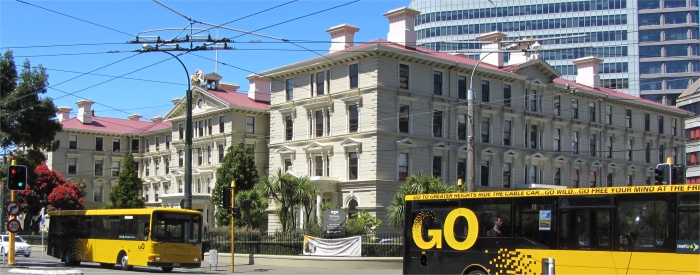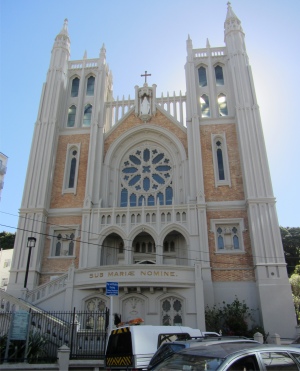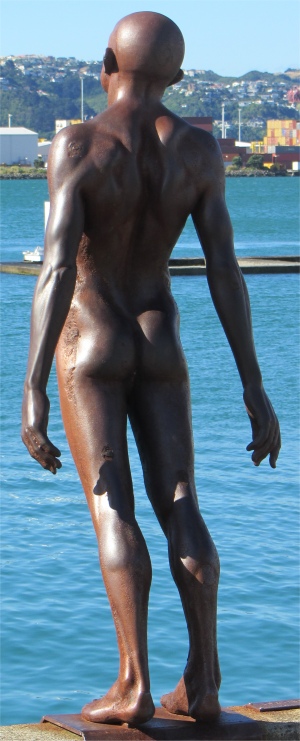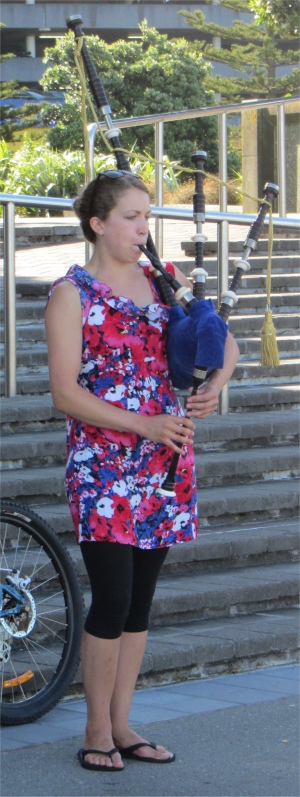 Old Government Buildings - Made Entirely Out of Wood |
I awoke and it was dark and raining cats and dogs. I thought it must be around 5am, I always wake up before the alarm goes off. I checked the time, it was only 22:50! I couldn't get to sleep after that. 6am came and I crept off to the bathroom in a light drizzle. My Dutch neighbours were also up and about; they were catching the same ferry.
 Saint Mary of the Angels |
The ferry passengers were not a joyful bunch. Either the Picton rain had defeated them, they were still half asleep, or both. As opposed to my trip out on the ferry, people were not flooding the decks outside taking snaps as we sailed down the Queen Charlotte Sound. We all collectively dozed. Miraculously, as we approached the Wellington waters the skies started to clear, and we collectively brightened up.
I needed shower facilities, so rather than stay overnight in the Te Papa car park again, I headed to the outskirts of the city at Newlands, the nearest site I could get to the city, and based myself there. The guide book said the site was functional. They were quite correct. Basically it was a motel with a large area of asphalt at the back for vans and motorhomes; no good for tents at all. It had the advantage of having a city bus stop right outside, and at $6 for an all-day travel ticket, who could complain.
 Me About to Dive |
Established in Auckland in 1854, the New Zealand Parliament moved to the General Assembly Building in Wellington in 1865. When fire destroyed that building in 1907, Parliament House was built - home to Parliament since 1918 except between 1991 and 1995 when the building closed for refurbishment. A temporary debating chamber was established in Bowen House during this time. The refurbishment saw furniture removed and new rimu desks installed to accommodate increased numbers. The House first met again in the restored Chamber in 1996.
 Girl Piper |
The Executive Building was where the Prime Minister and Cabinet Members had their offices, and also accommodation. The higher the rank, the higher the office. The House of Representatives was equivalent to the British House of Commons; there is no second chamber in New Zealand. The library was a stunning building of Victorian gothic design. It too had been damaged by fire in the past, and had been refurbished.
What I did find fascinating was that one of the most significant aspects of the 1992-1995 refurbishment project was the separation of Parliament House and the Parliamentary Library from their original foundations and placing the buildings on 417 rubber bearings, using base isolation techniques.
The aim of base isolation is to reduce the transfer of earthquake forces from the foundations to the building above, thus significantly reducing the need for extensive and intrusive strengthening concrete shear walls throughout the buildings.
The structural design for this approach was based on earthquakes of an intensity between the Modified Mercalli scales of MM9 and MM10. At this intensity, while ordinary non-seismic masonry buildings would be heavily damaged and cracking of the ground would be conspicuous, Parliament would escape largely unscathed with only minor non-structural interior damage.
In essence, the building's structure becomes very much a stiff box on top of horizontally flexible supports. The ability for the building to move up to 300mm sideways means the creation of a "moat" wherever the bearings are below ground level. This occurs virtually around the entire perimeter of the Library and the north and east sides of Parliament House.
For this project the bearing subcontractor, Dynamic Isolation Systems, developed a hybrid isolation system comprising high density rubber in combination with lead cores. All 417 of these bearings use steel shims sandwiched between layers of rubber. The bearings were all manufactured in Lower Hutt, Wellington, and the firm is now exporting the same product worldwide.
After the tour, I was allowed to sit in the Public Gallery of the House of Representatives and listen to a live debate taking place. Most of the days work had been done, but 10% of the seats were still occupied. I couldn't find the thread of their debate at all. One chap was praising the Chinese involvement in the exploitation of the mineral resources along the South Island West Coast, much to the annoyance of the opposition. A woman was pushing for a more harmonious country (Maori and Pakeha, not musical). Another chap was praising the sterling work being carried out in Christchurch, praising the Speaker, in fact he was full of praise. Then a woman got up and spoke in Maori for a while, the rest of the House sitting in stunned silence until she translated what she had said, which was not a lot, and then carried on in Maori. I gave up at this point and left; it was basically a talking shop today.
I took a long walk by the water front, and admired a young woman playing bagpipes; that was the first time I have seen a woman piper. I ended up in a bar watching rugby on one of the large screens. The young barman had managed to get a ticket to watch the Wellington Seven's; he had contacts that played for Wellington. I had missed it all by a week. I stayed until I could get a bus back to site, then wound my way back for some much needed sleep.
